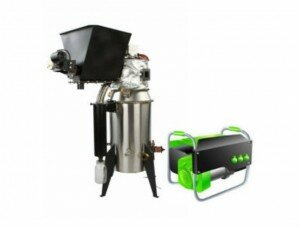Palm oil mills are in an enviable position to harness enormous amounts
of renewable energy with high efficiency, the potential which remains largely unrealised, palm oil expert Krishna Moorthy says.
An abundance of renewable energy can be utilised optimally within the palm oil mill to supply heat energy for industries and excess electricity generated for rural electrification or the grid.
A typical 60 tonnes per hour palm oil mill will be easily able to export 5 MW electricity to supply about five thousand rural homes. The mill has 50 MW of renewable energy in the form of prime biomass by-product that can be harnessed.
The balance of the energy can be distributed as biomass fuel for in-house heat or electricity generation in the industries. The energy value of the biomass in each mill will replace several million yearly fuel oil . Break-thorough technologies have been developed for deployment to harness the enormous energy resource at palm oil mills.
This measure while contributing immensely to the environment by reducing carbon footprint of the oil palm industry, achieves a much needed rural
electrification with good return on investment (20 percent IRR).
With the imminent energy price increase, oil palm growing countries need to consider industrial heat energy alternatives to keep their industries competitive and carbon footprint low. For example, the potential for Malaysia is a reduction of 80 million tonnes of CO2 per year by this means.
- 1 MovEnergy Engine 25KW
– 1 fuel tank 20 liters (range 15 hours)
– 1 Power Electronic
– 1 Voltage Regulator
Weight about 60 kg
Frequence 50hz 400v/230v/130v
costs only 3 cents per kwh
excess combustion air
*complete oxidation combustor
Technology
Palm oil mills are generally focused on milling operations. They are therefore predominantly concerned with the core business revolving around the processing of fresh fruit bunches (FFB) and its oil extraction rates. However, there is a new premise that allows such mills to operate as energy centres with enhanced energy efficiency.
Palm oil mills are able to harness enormous amounts of renewable energy at high efficiencies, from a source generally regarded as a waste product. The bulk of the fresh fruit bunches from the field transported to a palm oil mill for processing is discharged as biomass residue. This is an abundant source of renewable energy. Optimising the harnessing of the renewable energy reduces carbon dioxide emissions of palm oil production, and hence its carbon footprint.
Cogeneration
The most efficient way of exploiting biomass for energy is by principle of cogeneration. This principle is also known as combined heat and power (CHP) where the residual heat from a power generation process is recovered as usable heat for a downstream process. This allows to achieve high energy conversion efficiencies of higher than 80 percent.
While palm oil mills have already been using this principle for quite some time and are now mostly self-sufficient in energy supply, the potential of the biomass energy has not been fully optimised. Mills are continuing to run processes that were designed at a time when the awareness of renewable energy was not at the fore.
Biomass Electric Generator 25KW

- 1 Gasifier Biomass or Wood without filters
- 1 MovEnergy Generator 25KW
costs only 3 cents per kwh excess combustion air *complete oxidation combustor
Innovative systems
Today, innovative methods and systems are already available to release renewable energy potential and vastly improve energy efficiency at the mills. A new direction involves tackling three areas, namely evening out erratic process steam demand, reducing steam consumption of the process and lowering the process steam temperature.
Currently, at palm oil mills, steam blow off to atmosphere takes place at several locations, wasting large amounts of energy. There exists simple readily available systems for buffering erratic process steam demand of the palm oil process. These can be adopted to isolate the fluctuations from steam generators and steam turbines, enabling them to operate efficiently.
The initial process in the extraction of palm oil is thermal treatment of the FFB in large steriliser vessels as a batch process which consumes a major portion of process steam. Due to current inefficient air removal from the vessels, the stack of fruit bunches placed in the steriliser are unable to achieve a uniform temperature to attain adequate thermal treatment. Innovation allows for efficient air removal from the vessels at the start of a sterilisation cycle. This permits adequate thermal treatment with shorter time for sterilisation, lower process steam temperature and less steam consumption, all of which translates into drastic improvement in energy efficiency.
The present use of steam is at a temperature of 143 ºC and 4 bar steam pressure. However the palm oil extraction process temperatures require no more than 110 ºC. Hence current use of steam temperature should be questioned. Improving heat transfer to various processes can lower the process steam temperature down to 110 ºC, vastly improving efficiency of power generation by the steam turbine.
The requirement for low temperature usable heat at the mill provides an avenue for high efficiency energy conversion for the biomass. The power to heat ratio of the palm oil extraction process at the mill is low. For that reason there exists a potential to generate additional power at high efficiency to fit within the usable heat consumption. However this can only be tapped in locations where the additional power can be exported and distributed around local networks and the grid. Lack of power export facility may be a limitation to achieving the optimal energy conversion potential at the mill. Nevertheless, much can be achieved in terms of energy efficiency to conserve biomass at the mill and exploit the potential elsewhere.
It is a misconception in the palm oil industry that even where there is grid access it cannot contribute to energy efficiency. This can be done by way of additional power generation via CHP using surplus biomass if there is no adjacent large steam consuming plant to utilise the usable heat. CHP at the mills need only be sized to fit the usable heat consumption, while surplus biomass could be conserved for CHP implementation at a location elsewhere, wherever there is a usable heat consumer. Such operating practice would not incur any loss of energy in biomass utilisation.
Additional revenue streams from the sale of electricity and biomass fuel can represent significant income for a mill at present energy prices. Environmental improvements can therefore, surprisingly, also improve profits (Krishna Moorthy, Personnel communication, 2014).

